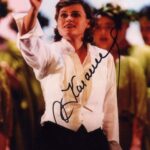In a previous article I discussed the various female operatic voice types. It is now time to talk about the male voices.
TENOR
In traditional operas, the hero is usually a tenor. This is the highest-pitched of the natural male voices. Like their soprano counterparts, tenors come in a few different types.
The highest and lightest of the operatic tenor voices is the tenore leggiero. You will often hear them referred to as “Rossini tenors,” because they specialize in the lighter bel canto repertoire, as can be found in the operas of Rossini, Bellini and Donizetti. Sometimes the term tenorino, or “little tenor” is heard, but this is inaccurate and pejorative. Any operatic voice, even the lightest one, has to be large enough to be heard in a theater, over an orchestra, without a microphone. In addition, the technique required to sing bel canto music requires the same years of training and the same vocal and physical stamina as is the case with bigger voices. Juan Diego Flórez and Lawrence Brownlee are good modern examples of this type of tenor. Luigi Alva has left us some great recordings of his work from the mid-20th Century.
Next comes the lyric tenor. A lyric tenor’s voice is larger and more “full” than that of the tenore leggiero. Although many lyric tenors sing bel canto repertoire, they are also able to branch out into some of the slightly “heavier” repertoire, such as Massenet’s Werther or Rodolfo in Puccini’s La Bohème. Luciano Pavarotti was a lyric tenor. Other examples of great lyric tenors were Fritz Wunderlich and Alfredo Krauss.
A spinto tenor is midway between a lyric tenor and a dramatic tenor. A spinto tenor voice has the volume and thrust of a dramatic tenor, while retaining the sweetness of the more lyric voices. This enables them to sing a wide variety of repertoire. Many of the great tenors have been spintos, including Giuseppe di Stefano, Jussi Bjoerling and Franco Corelli. The legendary Enrico Caruso was probably a spinto tenor, also. He possessed a voice of great volume and dramatic intensity, yet throughout his career he also continued to sing, beautifully, much of the lighter repertoire.
A dramatic tenor has a voice of great power, and specializes in singing roles requiring sustained full-voiced singing, such as Canio in Leoncavallo’s I Pagliacci and Radames in Verdi’s Aïda. Mario del Monaco was one of the greatest of the dramatic tenors. Jon Vickers was another.
A subdivision of the dramatic tenor is the heldentenor, or Wagnerian tenor. This is the biggest of the tenor voices, and is particularly suited to the operas of Richard Wagner. It is also the lowest-pitched of all the tenor types. Perhaps the most famous heldentenor of all time was Lauritz Melchior. Ben Heppner is probably the best known of the modern heldentenors.
BARITONE
The baritone voice is pitched lower than the tenor voice and higher than the bass voice. Baritones usually portray villains in traditional operas. Again, baritones come in different types.
The lyricbaritone voice is the lightest type. (Again, the term “light” is relative. A voice considered light in an opera house would be considered huge anywhere else.) Like the tenore leggiero, a lyric baritone will often sing bel canto repertoire, in addition to a variety of other roles. Thomas Hampson is a good modern example of a lyric baritone.
The dramatic baritone voice has a bigger volume and dramatic thrust than the lyric baritone. The composer Giuseppe Verdi wrote many of his best baritone villain roles for this voice type. The great Leonard Warren was this type of “Verdi baritone.” Another example is Sherill Milnes.
The bass-baritone or heldenbariton is a type of dramatic baritone best suited for German opera, including the operas of Richard Wagner. This voice type is pitched slightly lower than the other baritone types, and many bass-baritones travel easily between some of the standard bass repertoire and the Wagnerian baritone repertoire. Hans Hotter was a great heldenbariton. The best-known modern example is James Morris.
BASS
The lowest of all the male voices is the bass. With some notable exceptions (such as Mussorgsky’s Boris Godunov and Mozart’s Don Giovanni), basses are cast as older men or in character roles. There are three types of operatic bass voice.
The basso cantante is the equivalent of a lyric or spinto bass. Most of the great Italian operatic bass roles were written for this type, and the role of Don Giovanni is often sung by a basso cantante as well. Ezio Pinza and Cesare Siepi were prime examples of great bassi cantanti. In more recent times, there has been Samuel Ramey.
The basso buffo is a basso cantante who specializes in comic roles, usually, although not always, in bel canto operas. Salvatore Baccaloni and Fernando Corena were famous bassi buffi.
The basso profondo voice is the lowest and biggest of the bass voices. The role of Boris Godunov was written for a basso profondo. Perhaps the most famous basso profondo of all time was the Russian bass Fyodor Chaliapin. In more recent times, there was the Finnish bass Martti Talvela.
This completes my descriptions of the different operatic voice types.
Source: My own knowledge and experience in the field of opera.


